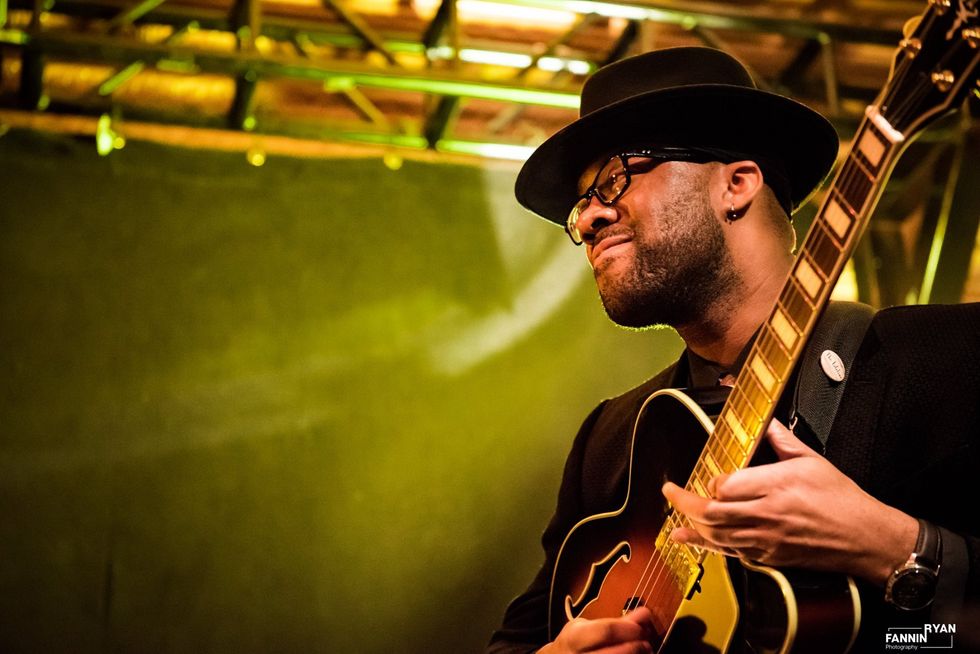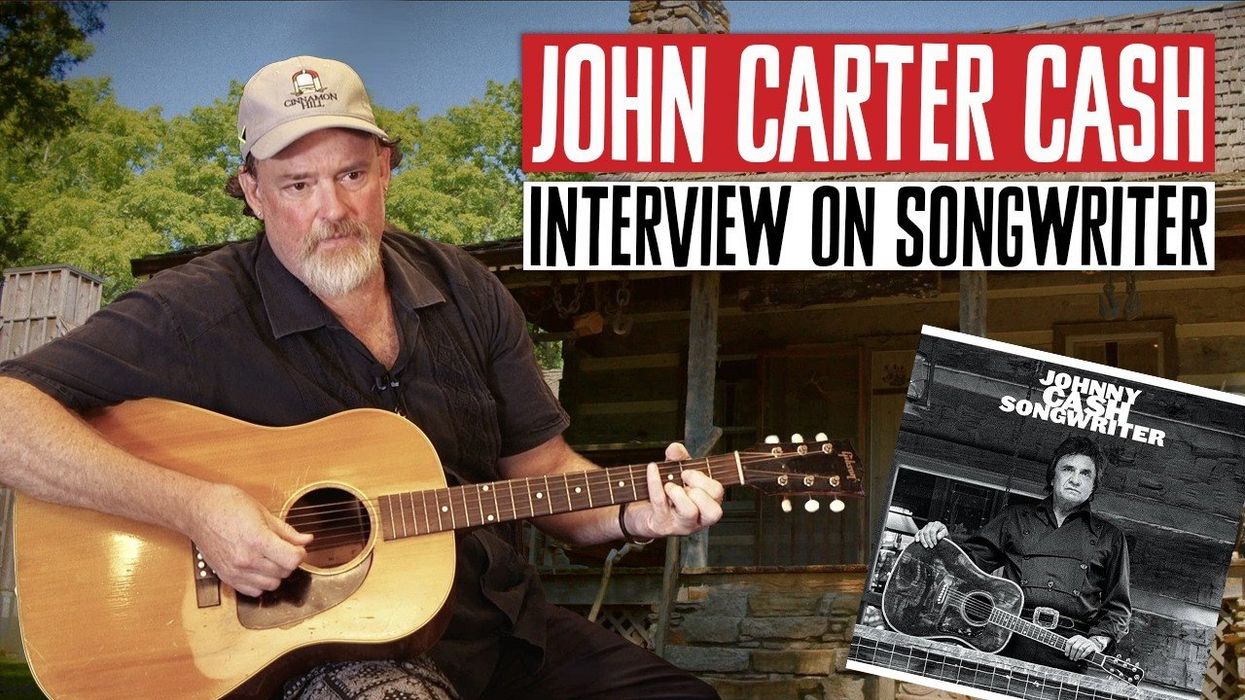
Twenty watts of tube power, tweed, and modern touches from attenuation to direct recording capability distinguish the newest version of a Peavey staple.
Flexible and full of practical features. Capable of spanning many Fender- and Vox-style sounds. Useful attenuator.
Clean channel can lack dimensionality. Lead channel can be sizzly in the top-end range.
$999 street
Peavey Classic 20
peavey.com
Perhaps it’s just coincidence, but lately I’ve had a few chats where chums and acquaintances recalled Peavey amps with great fondness. Just a few months back, a friend I play with showed up to a show beaming with pride for having scored an old Studio series combo from the ’90s on the cheap, and I know a few bass players who are always on the hunt for ’80s Peavey bass heads.
But the most affectionate reflections always seem reserved for the tweed-covered amps fromPeavey’s Classic series. In our First Look video for the Peavey Classic 20 reviewed here, my colleague John Bohlinger recalled using a pair every night for a television show on which he was musical director. And I’ve run into Classic 30s and Classic 50s in a number of backline situations that were always easy to work with and get solid sounds from, and didn’t render my guitar and pedals unrecognizable.
I don’t know if this nostalgia for old Peaveys is a widespread phenomenon. I have some pretty weird musician friends. But if a reappraisal of these workhorse amps has become a recent feature of the guitar zeitgeist, Peavey’s EL-84, 1x12 reboot of the Classic 20 is well timed.
A Bit of English Tweed
My guess is that a lot of Peavey Classic-series customers over the years assumed they were Peavey’s homage to a 1950s Fender Deluxe or Bassman. But despite the cosmetic similarities, Peavey’s Classic-series amps have more in common—at least in terms of tube complement—with English stalwarts like the Vox AC15 and Marshall 18-watt. In fact, the closest Fender equivalent might be the Blues Junior, which, like the Classic 20, AC15, and 18-watt Marshall 1974X, uses two EL84 power tubes and three 12AX7 preamp tubes. Of course, tubes are far from the only factor in shaping an amp’s tone signature, and sometimes the differences between Brit- and American-style amps aren’t as stark as you might imagine. I’ve certainly coaxed some pretty tweed-Deluxe-like tones from 2xEL84 amps.
The Classic 20 definitely possesses qualities of English- and California-bred amplifiers. In my time with the amp, I often heard a less throaty version of a Fender ’65 Deluxe Reverb (which was among the amps I used for comparison). But the Peavey also exhibits the less squishy, more immediate attack and extra midrange you’d hear from an AC15. For players unsure about taking the Vox or Fender path, the Classic 20 could be a middle ground worth exploring.
“For players unsure about taking the Vox or Fender path, the Classic 20 could be a middle ground worth exploring.”
Where the Peavey really differs from many more traditional famous and ubiquitous rivals is in the features tailored for performance, recording, and practice flexibility. Unlike a Deluxe Reverb or an AC15, the Peavey has a midrange control that goes a long way toward coaxing out more British or more American inflections, depending on how you scoop or boost it. It also has footswitchable rhythm and lead channels, the latter of which features a post-gain volume so you can more easily tailor the volume relationship between the two channels. An attenuator enables switching between 20 watts, 5 watts, and 1 watt. There’s an effects loop as well as XLR and USB outputs that work with an onboard speaker simulator for running straight to a PA or recording interface. There’s a pretty decent digital reverb, too.
Stepping into the Tweedlight Zone
In the cleaner rhythm channel, the Classic 20’s ability to span American and British personalities pays dividends and reveals some limitations. The Peavey’s midrange control adds breath and heat to PAF humbuckers that can be harder to coax from a black-panel-style amp lacking a midrange control. It also gives single-coil pickups a very sprightly, jangly feel. But the clean channel can also seem to lack dimension and complexity at times. You probably won’t notice it too much in the absence of an A/B test—and I definitely subjected the Classic 20 to some very unfair toe-to-toe comparisons with vintage and boutique amps. Even still, the clean channel can feel a little tight and less bejeweled with overtones than it could be.
The lead channel, too, comes with some compromises. It can be awesome for generating fiery solo tones that contrast sharply with the clean channel. But the shared EQ means that some of the liveliest, most dimensional clean channel EQ profiles can sound downright sizzly in lead mode. And while power-chord riffing can drip with sass, top-end content can sound a little crisp even at modest treble settings.
The Verdict
The Classic 20 does a lot for just less than 900 bucks. It’s powerful enough for gigging with a band, and its modest size, attenuator, and XLR and USB outputs and speaker simulator make it a practical solution for all kinds of recording, practice, and writing situations—even in small quarters. It would be interesting to see whether a switch from the Peavey’s Sheffield 1230 speaker included in the Classic 20 (which is loosely based on a Celestion V30) to another type would tilt the Classic 20’s characteristics more completely in an English or American direction. And indeed, some of what might be perceived as a relative lack of dimension and stiff top-end output could be down to the stiffness of a brand-new speaker. In general, though, the Classic 20 offers a lot of satisfying, growling, and sparkling tones, flexibility, and practicality for the price.
Peavey Classic 20 Demo | First Look
The Man in Black returns with the unreleased Songwriter album. John Carter Cash tells us the story.
“The Man Comes Around” is a much-played song from the final album Johnny Cash recorded before his death in 2003, American IV: The Man Comes Around. Now, the Man in Black himself has come around again, as the voice and soul of an album he initially cut in 1993, titled Songwriter. It hits the street on June 28.
For fans who know Cash only through his much-loved American Recordings series, this is a very different artist—healthy, vital, his signature baritone booming, his acoustic playing lively, percussive, and focused. This is the muscular Johnny Cash heard on his career-defining recordings, from his early Sun Records sides like “Cry! Cry! Cry!” and “Folsom Prison Blues” to “Ring of Fire” and “Sunday Mornin’ Comin’ Down” to later, less familiar hits like “The Baron” and “That Old Wheel.” In short, classic Cash—the performer who became an international icon and remains one even 21 years after his death.
I recently visited the Cash Cabin recording studio—a log cabin on the Cash family property in Hendersonville, Tennessee, that was originally built as a sanctuary where Johnny wrote songs and poetry—with PG’s video team of Chris Kies and Perry Bean to talk about Songwriter with John Carter Cash, the son of Johnny and June Carter Cash.
In addition to getting the lowdown on Songwriter from John Carter Cash, he showed us some of the iconic guitars—including original Johnny Cash lead guitarist Luther Perkin’s 1953 Fender Esquire and a Martin that was favored by the Man himself—that dwell at the busy private studio. Check out this visit.
Guest picker Mei Semones joins reader Jin J X and PGstaff in delving into the backgrounds behind their picking styles.
Question: What picking style have you devoted yourself to the most, and why does it work for you?
Guest Picker - Mei Semones

Mei’s latest album, Kabutomushi.
A: The picking style I’ve practiced the most is alternate picking, but the picking style I usually end up using is economy picking. Alternate feels like a dependable way to achieve evenness when practicing scales and arpeggios, but when really playing, it doesn’t make sense to articulate every note in that way, and obviously it’s not always the fastest.
Obsession: My current music-related obsession is my guitar, my PRS McCarty 594 Hollowbody II. I think it will always be an obsession for me. It’s so comfortable and light, has a lovely, warm, dynamic tone, and helps me play faster and cleaner. This guitar feels like my best friend and soulmate.
Reader of the Month - Jin J X

Photo by Ryan Fannin
A: For decades, the Eric Johnson-style “hybrid picking” with a Jazz III for “pianistic” voicings. Great for electric, though not so much acoustic. I’ve been recently learning to use a flatpick, à la Brian Sutton, by driving the pick “into” the string at an angle—which makes me think of Pat Metheny and George Benson, without irony.
Obsession: I’m still focused on understanding the concepts of jazz, neo-classical, and beyond, though I’m also becoming obsessed with George Van Eps’ 7-string playing, flatpicking, hip-hop beats, the Hybrid Guitars Universal 6 guitar, and the secret life of the banjo.
Editorial Director - Ted Drozdowski

A: Decades ago, under the sway of Mississippi blues artists R.L. Burnside, Junior Kimbrough, and Jessie Mae Hemphill, I switched from plectrum to fingerstyle, developing my own non-traditional approach. It’s technically wrong, but watching R.L., in particular, freestyle, I learned there is no such thing as wrong if it works.
Obsession: Busting out of my songwriting patterns. With my band Coyote Motel, and earlier groups, I’ve always encouraged my talented bandmates to play what they want in context, but brought in complete, mapped-out songs. Now, I’m bringing in sketches and we’re jamming and hammering out the arrangements and melodies together. It takes more time, but feels rewarding and fun, and is opening new territory for me.
Managing Editor - Kate Koenig

A: I have always been drawn to fingerpicking on acoustic guitar, starting with classical music and prog-rock pieces (“Mood for a Day” by Steve Howe), and moving on to ’70s baroque-folk styles, basic Travis picking, and songs like “Back to the Old House” by the Smiths. I love the intricacy of those styles, and the challenge of learning to play different rhythms across different fingers at the same time. This is definitely influenced by my classical training on piano, which came before guitar.
Obsession: Writing and producing my fifth and sixth albums. My fifth album, Creature Comforts, was recorded over the past couple months, and features a bunch of songs I wrote in 2022 that I had previously sworn to never record or release. Turns out, upon revisiting, they’re not half bad! While that one’s being wrapped, I’m trying to get music written for my sixth, for which I already have four songs done. And yes, this is a flex. 💪😎
Guitarist, songwriter and bandleader Grace Bowers will independently release her highly anticipated debut album, Wine On Venus, August 9.
The new album adds to a breakout year for Bowers, who was recently selected as a U.S. Global Music Ambassador as part of the U.S Department of State and YouTube’s Global Music Diplomacy Initiative, is nominated for Instrumentalist of the Year at the 2024 Americana Music Association Honors & Awards and will make her debut performance on the legendary Grand Ole Opry on her eighteenth birthday, July 30, 2024. Other performances this year include shows supporting Slash, The Red Clay Strays and Brothers Osborne as well as stops at Levitate Music & Arts Festival, Floyd Fest, Bristol Rhythm & Roots Reunion, Bourbon & Beyond, XPoNential Music Festival and Pilgrimage Music & Cultural Festival. See below for complete tour itinerary.
Grace Bowers & The Hodge Podge - Tell Me Why U Do That (Official Video)
Produced by John Osborne (Brothers Osborne), Wine On Venus captures the electric energy of Bowers’ live performances with The Hodge Podge. The record consists of nine soul-infused tracks including a new version of Sly and the Family Stone’s “Dance to the Music” as well as previously release single, “Tell Me Why U Do That,” of which Forbes praises, “an infectious, joyous party and a worthy introduction to Bowers.” Additionally, The Bluegrass Situation declares, “an exceptional breakout talent who seems primed for a long career to come,” while RIFF Magazine calls her “The next generation’s star of American rock, blues and funk guitar.”
Of the record, Bowers shares, “I’m so excited to share my first album with the world in August! It’s been a long time coming, and I’m proud of what was created with the incredible Hodge Podge and John Osborne producing. We recorded everything live, as it should be, for this sonic journey. I hope you love it as much as I do.”
Additionally, of the title track, she reflects, “My nana was 100 years old when she passed away last year. She would always tell me that when she died, she would be drinking wine on Venus. She was a little eccentric but thought that was just something so cool. When she passed, I wrote a song about it.”
In addition to Bowers (guitar), the record features Joshua Blaylock (keys), Brandon Combs (drums), Eric Fortaleza (bass), Esther Okai-Tetteh (vocals) and Prince Parker (guitar) as well as songwriting collaborations with respected artists such as Ben Chapman, Meg McRee, Maggie Rose and Lucie Silvas.
Originally from the Bay Area and now calling Nashville home, Bowers began garnering attention after sharing videos of herself playing guitar on social media during the pandemic. In the years since, she’s been featured on “CBS Mornings” in a piece focused on a new wave of young female guitarists, performed alongside Dolly Parton as part of her Pet Gala special on CBS, joined Lainey Wilson as part of CBS’ New Year’s Eve Live celebration, performed as part of the “Men’s Final Four Tip-Off Tailgate Presented by Nissan” and been sought after by everyone from Devon Allman to Tyler Childers and Susan Tedeshi to Kingfish. Of her 2023 Newport Folk Festival debut, Rolling Stone declared, “Her 20-minute performance gave the distinct sense that everyone lucky enough to have attended was witnessing a star in the making,” while The Tennessean calls her “a 17 year old Blues guitar prodigy,” with a, “heart as big as her talent is vast.”
Most recently this summer, Bowers performed alongside Billy Idol at the Fired Up For Summer benefit concert and raised $30,000 for MusiCares and Voices for a Safer Tennesseewith her 2nd Annual “Grace Bowers & Friends: An Evening Supporting Love, Life & Music” benefit show. With the release of Wine On Venus (distributed by The Orchard), Bowers will further establish herself as one of music’s most intriguing new artists.
For more information, please visit gracebowers.com.
The new destination on Reverb will feature an always-changing collection of new and like-new music gear from top brands for at least 20% off retail prices.
“Outlet music gear is a fantastic value for music makers. Often, it’s brand new overstock or clearance music gear that retailers or brands are simply looking to clear out. Other times, it’s gear that’s been opened, used for a demo, or simply doesn’t have its original box, but is otherwise in like-new condition,” said Jim Tuerk, Reverb’s Director of Business Development. “With the launch of the Reverb Outlet, we’re making it easy to access your favorite brands for less.”
The Reverb Outlet will feature high-quality discounted music gear from Reverb’s community of authorized sellers, ranging from retailers like ProAudioStar and Alto Music to brands like Focusrite and Korg selling discounted items directly to music makers. All of the new and like-new music gear in The Reverb Outlet:
- Is at least 20% off retail prices—but often more
- Is sold by authorized retailers and brands
- Comes with free shipping, and
- Has a minimum 7-day return window.
“With economic pressures making it harder for music makers to invest in music gear, it’s more important than ever that the music-making community has access to affordable musical instruments. We launched the Reverb Outlet to make it easier for music makers to find the best deals on the instruments that will inspire them,” said Reverb CEO David Mandelbrot. “Now that players can shop discounted outlet music gear alongside our huge range of affordable used music gear, it’s easier than ever to find the perfect instrument for your budget.”
Visit the Reverb Outlet today and check back often, as new deals will be added regularly. Please note that as of now, this is available to those in the US only.
For more information, please visit reverb.com.




